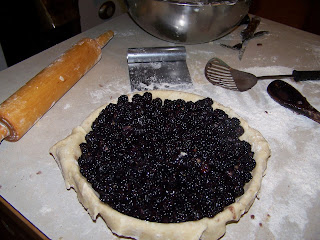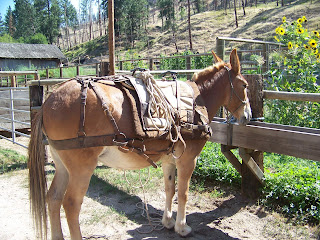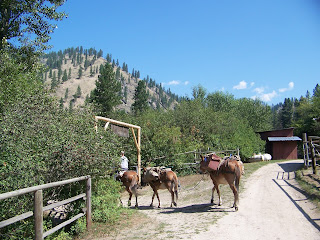It is once again time to give those horses and mules new shoes!! The horses at Shepp Ranch are shod three times per year and always just before hunting season. Shepp Ranch horseshoe man is Shane Hendren, sole owner/proprietor of Lucky H Horseshoeing. Shane has been a farrier for 11 years. He went to farrier school in Oklahoma for 6 weeks and has had a few very special mentors along the way. Shane shoes about 750 head of stock a year. He charges $60 a head, or $15 per shoe. Not bad for such precise, difficult and potentially dangerous work. Horses and mules are shod for the same reasons we wear shoes, for protection. Pack animals in the mountains especially need shoes as they are walking on steep trails over rocks and crevices which can sometimes be treacherous.
For horseshoeing Shane wears a piece of protective clothing called chaps. The chaps you see below were made by Jerry Combs in Clarkston WA, a friend and mentor of Shane's. They are made of very thick leather which prevent any nails from driving into Shane's legs as he shoes and in general they are just for soft tissue protection.
Shane wearing his protective chap . . . . . . . .
Shane has his toolbox which he usually takes right next to the mule or horse while he is shoeing. If the animal is in any way skittish he will not take his toolbox too close.
Shane's quasi toolbox . . . Most farriers have a traditional tool box . . . .
Shoeing starts by pulling off the old shoes. Here Shane uses shoe pullers and a clinch cutter to remove the old nails and subsequently the shoe.
Removing the old shoes . . . . . .
Next he cleans out the hoof of any debris and caked in dirt with a hoof pick.
Shane cleans out the hoof with a hoof pick . . . ..
Then he trims the outside of the hoof that has grown since the shoeing with a tool called nippers. He trims down to the 'white' part of the hoof, which is not the 'quick' as we have under our nails. The animal feels no pain during this process.
Trimming the hoof . . . . .
After trimming he uses a rasp to file down the hoof and make it smooth. It is essentially the same thing we use - a nail file, except his of course is much bigger :-)
Using the rasp to file the hoof smooth . . . . . . .
The actual shoes come next. He selects a size and places it on the hoof for inspection. Usually he has to hammer the shoe on his anvil to make it a perfect and close fit.
Checking the shoe for size on the hoof . . . . .
Hammering the shoe on the anvil to perfect the size for the hoof . . . .
After fitting he nails on the shoe. He wrings off the excess nail that goes through the hoof with the claw of his hammer.
Wringing off the excess nail . . . . ..
Cinching the nails . . . . . .
The finishing touches are again using a rasp to file off any extra hoof around the outside of the shoe and files off the ends of the nails to make them smooth so that nothing will catch on the hoof. Shane uses a hoof stand for the finishing touches.
Putting on the finishing touches . . . . . .
Shane will spend two days with us shoeing all of the mules and horses. I think we now have about 19 all told.

































